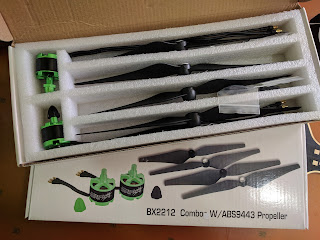So, I've ordered, and received the components (see my earlier post) to build my F550 Hexacoptor. So, now it was time to start building.
I ordered 3 pairs of Multistar 2212 920KV Motors. I got 3 boxes with the motor pairs.
The package came with the 3mm hex nuts to mount the motors, and bullet connectors with heat-shrink tubes to connect to the ESCs as well.
The propellers are 9043, and each box has an extra pair of props as well.
I got 6 Multistar 30A ESCs. They're smaller than I thought, which is even better.
Since I couldn't ship Li-Pos from HobbyKing, I managed to find a 3S 5500mAh 40C Li-Po from the local hobby shop - Hobby Tech Lanka.
I already had the F550 Frame and the NAZA-M Lite.
Bought the following items also before starting the build.
You also need a good quality soldering iron, solder, and flux.
But, before you start soldering, there's one important check to be done.
Since the bottom plate of the F550 Frame acts as the power distribution, it's always best to check whether there are any short-circuits on the frame before you begin. Any short-circuit might lead to damage to the electronics, fire, or even explosions of the Li-Po battery.
To check the frame, get the bottom plate (the one with the '+' and '-' pads), and use a multimeter to first check whether the '+' pads are not short-circuited to the '-' pads. Then, make sure the '+' pads are all connected together, and the same with the '-' pads.
Once we verified that, we are ready to start the build.
I ordered 3 pairs of Multistar 2212 920KV Motors. I got 3 boxes with the motor pairs.
 |
| The Multistar 2212 920KV CW/CCW Motor pairs with Props |
The package came with the 3mm hex nuts to mount the motors, and bullet connectors with heat-shrink tubes to connect to the ESCs as well.
The propellers are 9043, and each box has an extra pair of props as well.
 |
| The 9043 Propellers that comes with the Multistar Motors |
I got 6 Multistar 30A ESCs. They're smaller than I thought, which is even better.
 |
| The Multistar 30A ESCs |
Since I couldn't ship Li-Pos from HobbyKing, I managed to find a 3S 5500mAh 40C Li-Po from the local hobby shop - Hobby Tech Lanka.
 |
| The 3S 5500mAh 40C Li-Po from HTL |
I already had the F550 Frame and the NAZA-M Lite.
Bought the following items also before starting the build.
- A XT60 Connector with wires (make sure you consider the correct gauge of the wire)
- Double-sided Foam Tape (for mounting the components to the frame)
- Wire Tape (for insulation)
- Heat-shrink Tubes, if needed
- Cable ties (for cable management)
You also need a good quality soldering iron, solder, and flux.
But, before you start soldering, there's one important check to be done.
Since the bottom plate of the F550 Frame acts as the power distribution, it's always best to check whether there are any short-circuits on the frame before you begin. Any short-circuit might lead to damage to the electronics, fire, or even explosions of the Li-Po battery.
To check the frame, get the bottom plate (the one with the '+' and '-' pads), and use a multimeter to first check whether the '+' pads are not short-circuited to the '-' pads. Then, make sure the '+' pads are all connected together, and the same with the '-' pads.
 |
| The bottom plate of the F550 Frame |
Once we verified that, we are ready to start the build.
Comments
Post a Comment